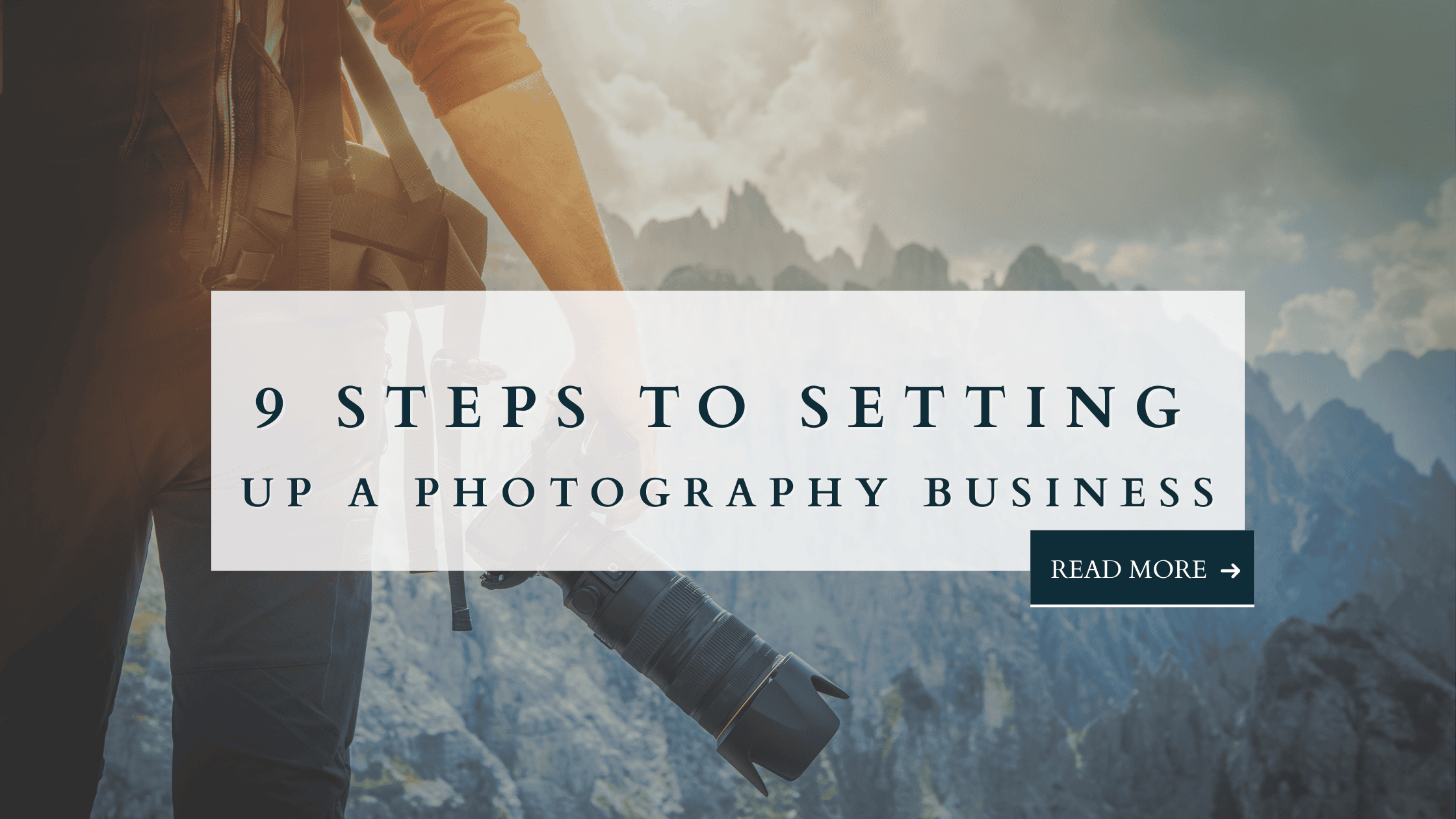9 Steps to Setting Up A Photography Business
Introduction:
For photographers who want to turn their passion for photography into their full-time business and what steps should you take to ensure it’s a success.
Bonus Material: A guide for writing a business plan to ensure your photography business is a success!
Starting a photography business is an exciting venture with opportunities to showcase your creativity and passion for capturing moments.
Whether you’re a budding amateur photographer or an experienced photographer ready to take the next step, establishing a solid foundation is most important. In this guide, 9 Steps to Setting up a Photography Business, I’ll walk you through the essential steps to help you set up your photography business and pave the way for a thriving career and a successful business.
1. Invest In Your Photography Equipment
Investing in quality photography equipment to deliver the best results to your clients. Your startup costs are business expenses and tax deductible. For this reason you should aim to buy the best equipment your budget will allow. Choose the right camera, lenses, lighting equipment, and accessories that meet your specific needs for your photography niche. Additionally, don’t underestimate the value of investing in educational resources, such as books, courses and workshops to enhance your skills and knowledge, not just photography learning, but business learning too. I’ll talk about the importance of learning further down in this blog.

2. Write A Plan
Crafting a comprehensive business plan is number 2 in my 9 steps to setting up a photography business as it’s vital for laying the groundwork for your photography business. The following will give you an idea of what should be included in a good business plan, especially if you intend to apply for any funding.
If you would like a more detailed plan of what to include in your business plan, I have a FREE PDF that you can download here.
Executive Summary
Business Description
Market Analysis
Marketing and Sales Strategy:
Organisational Structure and Management
Product or Service You’ll Be Offering
Financial Projections
Risk Management and Contingency Plans
Appendices.
A good business plan should provide a comprehensive roadmap for your business’s success, outlining your goals, strategies and action plans to achieve sustainable growth and profitability.

You may find it beneficial to have a goal planner that runs alongside your business plan.
A goals planner is used more on a daily basis and helps you to identify your SMART goals, perform SWOT analysis and helps you to break down each goal into actionable steps which will keep you on track. If you would like to check out the goal planners I’ve for sale in my Etsy shop, click here – there are digital ones as well as PDF options.

Create An Online Presence
Creating an online presence is crucial for the success of your photography business, and having a clear outline of how you intend to do this in your photography business plan will help you stay focused. In today’s digital age, potential clients often rely on the internet to discover and evaluate services, in other words, they would do a considerable amount of their market research when looking for local services on social media platforms.
Here are several compelling reasons why an effective online presence is essential, along with some practical steps to achieve it successfully:
Why an online presence is essential:
Increased visibility and reach.
- Global audience: The internet provides access to a global audience, significantly expanding your potential client base beyond local boundaries. Now I hear you, but I’m not going to travel 300 miles in my product photography or fashion photography business, however, you may want to reach customers 300 miles away or even the other side of the world if you create photographic art with some of the images you’ve taken at one of these photo shoots.
- Searchability: Having a well-optimised business website with your photography services and active social media accounts improves your search engine ranking, making it easier for potential clients to find you. Tapping into local events is an easy way to build up ideal clients in your local area and a great place to hone your business skills while obtaining potential clients’ contact details.
Brand building and recognition.
- Consistent branding: An online presence allows you to consistently showcase your brand’s identity through visual aesthetics and tone of voice. As professional photographers you need to have a clear plan about how you want your new photography business to engage with your customers so you can develop relationships and build brand awareness and trust. For instance, if you’re in the portrait photography niche, people may want to hear from some of your clients about their experiences and how easy you made them feel in their portrait sitting. By having a warm and inviting tone of voice will help your clients feel comfortable and relaxed.
Utilise online directories and listings:
- Many places have some form of a local online directory that small businesses can often have a free listing. The first step is to check out your local pages on Facebook. This will give you a good idea of what kind of groups are around that align with your target market. For instance, if you’re a newborn photographer, the first step is to see if any local mum and baby groups in your local area.
- Google Business: Set up a Google business profile in your business name. It’s completely free and will help prospective clients find your photography website. You can ask for reviews from your clients and keep them updated with your opening times over things like bank holidays, Christmas holidays etc.
Collaborate with other businesses.
New photographers not only need to develop their photography skills but also their communication and networking skills. Why not check out to see what other local businesses you may be able to collaborate with? For instance, is there a wedding dress shop in your town? You can rent a studio space for a wedding dress photo shoot. This will build your confidence as a small business owner and a photographer, it will help to increase both your and their social media presence with the amazing images you’ll capture on the day and will help to provide loads of marketing materials for both of you for months to come.
If you’re a wedding photographer, I have a blog here that I’ve written that also includes 30 days of social media post suggestions.

Included in my 9 steps to setting up a photography business is create a website
Your website serves as your digital storefront and should provide visitors with a seamless browsing experience.
Focus on creating a user-friendly website that highlights your portfolio, services, pricing and contact information. Incorporate a personal touch by sharing your story, interests and journey as a photographer to connect with potential clients on a deeper level.

Build Your Portfolio
A portfolio is a collection of your best work, showcasing your skills, style and expertise in capturing images. It serves as a visual representation of your abilities and helps potential clients or employers assess the photographer’s suitability for a particular project or job. A well-curated portfolio not only highlights your technical proficiency but also communicates your artistic vision, creativity and storytelling ability.
Best practices for creating a Photography Portfolio
Select Your Best Work.
- Choose a selection of images that represent your skills, style and areas of expertise. Focus on quality over quantity, including only your strongest and most impactful photographs.
Showcase Variety.
- Include a diverse range of images that demonstrate your versatility as a photographer. Showcase different subjects, styles, lighting conditions, and compositions to showcase your range and flexibility.
Organise Your Portfolio
- Organise your portfolio in a logical and cohesive manner to create a smooth viewing experience for your audience. Group similar images together, or organise them chronologically to tell a story or showcase a progression of your work over time.
Consider Your Audience.
- Tailor your portfolio to your target audience, whether it’s potential clients, employers or peers in the photography industry. Highlight work that is relevant and appealing to your intended audience, showcasing your ability to meet their specific needs and preferences.
Pay Attention to Presentation
- Present your portfolio in a professional and visually appealing manner. Use a clean, minimalist layout that allows your images to take centre stage. Consider using a high-quality print portfolio or a well-designed online portfolio website to showcase your work effectively.
Provide Context
- Accompany each image in your portfolio with a brief description or caption that provides context and insight into the story behind the photographer. Share details such as the location, subject, concept and any relevant anecdotes or challenges encountered during the shoot.
Update Regularly
- Keep your portfolio up to date by regularly adding new work and removing outdated or less relevant images. This demonstrates your ongoing growth and development as a photographer and ensures that your portfolio remains fresh and engaging to viewers.
Seek Feedback
- Seek feedback from peers, mentors or industry professionals to gain valuable insights and constructive criticism on your portfolio. Use this feedback to identify areas for improvement and refine your portfolio to better showcase your skills and vision.
These are the basic outlines for creating a compelling and effective photography portfolio. I would do some further research into creating a portfolio for your photography niche.

Attract Clients
Implementing a strategic marketing plan is essential for attracting clients and growing your photography business. Explore various avenues such as networking at business events, collaborating with local businesses and offering special promotions or discounts to attract new clients.
The importance of continuous learning for photography business owners.
Starting and running a successful photography business requires more than a passion for capturing beautiful family portraits, or amazing brand images. It demands a commitment to continuous learning and professional growth. Here’s why making time to learn and develop your skills is crucial, and how it can lead to the success of your photography business.
- Enhancing photography skills: Photography is both an art and a science, requiring a deep understanding of technical aspects and a creative vision. Continuous learning allows you to stay updated with the latest techniques, tools and trends in photography. Many successful photographers subscribe to online magazines like The Creator Lens, you can check them out here. The Creator Lens is a daily newsletter where 15000+ creative professionals get their news. They cover what matters in the creative industry, all the latest news, tools and tutorials.
- Stay current. Photography is an ever-evolving field with new technologies, trends and styles emerging regularly. By continuously learning, you are taking the important step to ensure that your work remains fresh and relevant. The photography industry, like any other, is subject to changes and disruptions. Continuous learning keeps you adaptable and prepared for these changes. For instance, there could be new legal requirements that you have to abide by if you’re niche is portrait photography and going into schools for student portraits. Keeping up with legal changes related to contracts, copyrights, business regulations and business registration ensures you remain compliant and protect your business interests
- Mastering techniques: Whether it’s mastering lighting, composition, or posing ongoing education helps you refine your craft and produce higher-quality work.
- Expanding your portfolio: Learning new photography techniques enables you to expand your portfolio, offering a broader range of services for clients and attracting a wider audience.

Improving Post-Production Skills.
Post-production is a crucial part of the photography process and photography businesses can claim the entire subscription costs back for a program like Photoshop. Proficiency in editing software like Photoshop and Lightroom can significantly enhance the quality of your final images.
- Professional Quality: High-level editing skills ensure your photos look polished and professional. This is essential for satisfying clients and maintaining a strong reputation in your own business. You can use videos of simple editing processes in your marketing strategy by showing before and after images.
- Creative expression: Advanced post-production techniques allow you to express your creative vision more fully, creating unique and impactful images.
- Efficiency: Learning shortcuts and advanced techniques in editing software can streamline your workflow, saving you time and increasing productivity.
Developing Business Acumen
Running a successful photography business involves much more than taking great photos. It requires solid business skills and keeping on top of small business administration to manage operations, finances, marketing, and client relationships.
Financial management
- budgeting, pricing, and financial planning is crucial for maintaining profitability and sustainability. Your business bank account or accountancy program may have some form of training on how best to manage your cash flow, especially in the early days of running your own photography business, so it’s worth checking this out.
Marketing Strategies
- Marketing is a vital component of any successful photography business. Effective marketing strategies can help you attract new clients, build a strong brand and create a loyal customer base. Learning about good digital marketing, the best way to create social media strategies and effective branding is the first thing that you should decide to learn early on. The simplest step-by-step guide to learning how to promote, and market your business will increase the success of your marketing efforts. By understanding who your ideal client is, you can tailor your marketing efforts to attract them specifically. I wasn’t a born salesperson or marketer, so I invested time and money and utilised learning platforms like Udemy, Coursera & LinkedIn Learning, which offer courses on digital marketing, social media strategies, SEO, content marketing and more. Many of these courses are less than £100, and once purchased you can learn at your own pace, so making sure you have allocated a set time each week in your working week, evenings or weekends is a great way you’ll be able to grow your knowledge in areas that you previously struggled with.
Books & Publications
- I am a lover of reading. I read both physical books and I have a Kindle. Books are a way for you to learn and grow your understanding of how to run a successful full-time business. Whether you’re a wedding photographer or your preference is in landscape photography, they are so different but both have to be marketed. They both need a solid business structure set out from the start. You need to have a good understanding of how to do this. I should point out that most learning resources that are either one-off-purchases or monthly subscriptions which have ongoing costs are tax deductible, but it is always worth checking your country’s tax laws.
Finding a mentor or business support
Having a mentor or business support can provide guidance, support, and valuable insights. If you’re thinking about whether this would be beneficial to you and your business, regardless if you’re in your first year of business or you’ve been in business for a number of years, here’s how to start looking:

Why a mentor or business support is important.
Experience: Mentors bring experience and can offer practical advice based on what has worked (or not worked) for them.
Avoiding Mistakes: They can help you avoid common pitfalls and mistakes that new business owners often make.
Networking Opportunities: Connections. A mentor can introduce you to valuable contacts in the industry, including potential clients, collaborations and other professionals.
Exposure: Being associated with an established professional can enhance credibility and exposure.
Skill Development: Mentors can teach you new skills, whether they are related to photography, business management or marketing.
Feedback: They provide constructive feedback on your work and business practices, helping you improve continuously
Emotional support: Encouragement: Starting a business can be stressful. A mentor provides encouragement and emotional support, helping you stay motivated and focused.
Perspective: They offer an outside perspective on your challenges and successes, helping you see things more clearly.

How to find a Mentor or Business Support
Identify Your Needs.
Specific Goals: Determine what areas you need help with, whether it’s technical photography skills, business management, marketing or all of the above.
Desired Traits: Consider what traits you value in a mentor, such as experience, communication style and availability. I found my business mentor and followed her online for many months before I engaged in her mentoring services. I wanted to know what her approach was in helping and supporting of female entrepreneurs. She’s turned out to be exactly what I needed, someone who is straight-talking, invested heavily in her own learning and she’s always available to her inner circle of women for advice in times of difficulty in business. She has helped me to navigate the challenges that running a business can throw up, so I’m glad and grateful that I found her.
Leverage your network.
Connections:
Start with your existing network. Ask friends, family and colleagues if they know anyone who could be a good fit.
Events: Attend industry events, workshops and seminars where you can meet potential mentors and business advisors.
I offer mentoring to startup photography businesses, so if you would like to discuss this further, then please don’t hesitate to reach out to me. You can email me here.
Join professional organisations.
Associations: Join photography and business associations. Many of these organisations have mentorship programs or can connect you with experienced professionals.
Groups: Participate in local business groups or photography clubs where you can meet experienced photographers and business owners.
Online platforms. Social Media: This is how I found my mentor. Look for groups and forums related to photography and business. My mentor doesn’t have a photography background, but her business knowledge is what I was lacking.
Mentorship Sites: Websites like SCORE, MicroMentor, and FindAMentor offer access to experienced mentors in various fields.
Reach out and ask: Direct approach: Don’t be afraid to reach out directly to potential mentors. Express your admiration for their work, explain your goals, and ask if they would be willing to mentor you.
Value Exchanges: Offer something in return, such as assisting them with their projects, to create a mutually beneficial relationship.
And finally, and the one I think is more important than anything ….
Never Give Up!
Building a successful photography business requires perseverance, determination and resilience. Remember that success doesn’t happen overnight, and setbacks are inevitable along the way. Stay focused on your goals, remain adaptable to change, and never lose sight of why you started this journey in the first place.
With dedication and passion, you can overcome any obstacle and turn your photography dreams into reality
In conclusion.
Setting up a photography business requires careful planning, dedication and a willingness to learn and grow. By following these eight essential steps and staying committed to your craft, you can build a thriving photography business that fulfils your creative aspiration and achieves your professional goals. Embrace the journey, stay true to yourself and never stop pursuing your passion for photography.
Happy snapping
Nicky x




